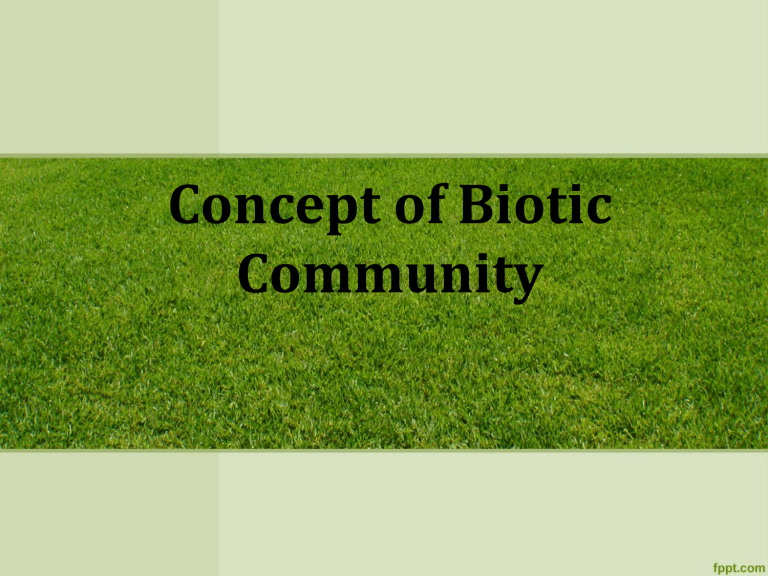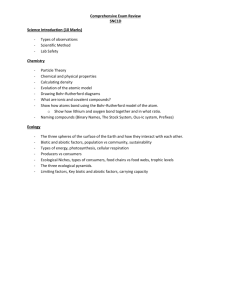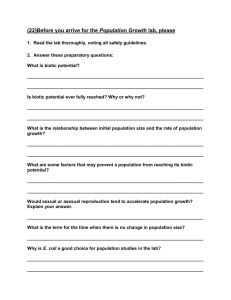
Concept of Biotic Community Biotic Community • also known as biota or ’biocoenosis’ • is the group of organisms that live together and interact with each other within an environment or habitat • Together, the biotic community and the physical landscape or abiotic factors make up an ecosystem. Types of Community o Minor communities Major communities o Are those communities more or less dependent on neighboring communities for energy They are secondary aggregations within a major community o Are those communities of sufficient size and completeness of organization o They are relatively independent of resources from adjacent communities o They receive only solar energy from the sun Concept of Biotic Community Community concept is important in ecological thought and in ecological practice because.. it emphasizes the fact that diverse organism live together in an orderly manner “as the community goes, so goes the organism” features… A community is an aggregate of organism of various sizes, which form a distinct features cont… • The size of community unit maybe large (forest community) or small (community of invertebrates) • Different community occurs in different habitat • The composition and character of a community is an indicator of the type of environment that is present cont… • The structure of a community is dependent on: a) the number of species b) the relative number of individuals in each species • Communities are constantly changing. The replacement of one community by another is called community succession. The final stage in community succession is a climax community • Species diversity indices give quantitative expression of community structure IntraCommunity Classification and Concept of Ecological Dominance Ecological dominance • is the degree to which a taxon is more numerous than its competitors in an ecological community, or makes up more of the biomass. • Most ecological communities are defined by their dominant species. • few species or species groups exert the major controlling influence by virtue of their numbers, size, production or other activities. • Major communities largely control the energy flow and strongly affect the environment of all other species cont… • Natural communities may have an even larger number of species. Even so, a relatively few species often control the community and are said to be dominant. • Removal of the dominant would result in important changes not only in the biotic community but also in the physical environment. • Removal of a non-dominant species would produce much less change • Generally, dominants are those species in trophic groups which have the larges productivity or biomass Intracommunity Classification therefore… goes beyond taxonomic listing and attempts to evaluate the actual importance of organisms in the community. bluegrass white clover oak trees beef cattle dairy cattle chickens turkeys sheep horses 48 acres 2 acres 2 individuals 2 individuals 48 individuals 6 individuals 2 individuals 1 individual 1 individual Species Diversity in Communities Species Diversity in Communities • Species diversity is the key features of biological communities • Species diversity affects the stability and productivity of communities • Species diversity declines as latitude increases • small percent of individuals are abundant while large percent are rare usually cont… • Few common species or dominants largely account for the energy flow in each tropic group • It is the large number of rare species that largely determine the species diversity of trophic groups and whole communities • Species diversity tends to be low in physical controlled ecosystem while high in biologically controlled ecosystem • Diversity is positively correlated with stability Pattern in Communities Pattern in Communities 1) 2) 3) 4) 5) 6) 7) 8) Stratification pattern (vertical layering) Zonation pattern (horizontal segregation) Activity pattern (periodicity) Food web pattern (network organization in food chain) Reproductive pattern (parent-offspring association, plant clones, etc.) Social pattern (flocks and herds) Coactive pattern (resulting from competition, antibiosis, mutualism, etc.) Stochastic patterns (resulting from random forces) Example of stratification Example of zonation Activity pattern The rhythmic changes occur in the activities of organisms. • Seasonal periodicity- temperate, rainfall and photoperiod determine the reproductive cycle of its inhabitants • Dial periodicity- animals of terrestrial community active during the day and inactive during the night Example of Food web pattern Reproductive pattern Asexual reproduction –relies entirely on mitosis 1. Fission 2. budding 3. fragmentation Sexual reproduction 1. Parthenogenesis – eggs develop w/out being fertilized. Ex: bees, wasps, etc. 2. Hermaphroditism – Some fertilize themselves but most fertilize mutually where each donates and receives sperms 3. Sequential hermaphroditism – an organism changes its gender throughout its lifetime Ecotones and Concept of Edge effect Ecotones and Edge effect • Ecotones, also called transition zone • was coined from a combination of eco(logy) plus -tone, from the Greek tonos or tension (a place where ecologies are in tension). • The zone where two or more different communities meet and integrate • It is a junction zone or tension belt but is narrower than the adjoining community cont… • The zone maybe narrow or wide, local (field and forest) or regional (forest and grassland) • Ecotone contain both communities • Species in ecotone is greater than in adjoining communities • It may also include a number of highly adaptable species that tend to colonize such areas cont… • the tendency of increased variety and density at the community border and spend the greatest amount of their time in junctions between communities is known as edge effect. • the ecotone between the field and the forest act as a refuge for species formerly found in the ploughed area • Some species requires to be in ecotone as part of their life cycle




